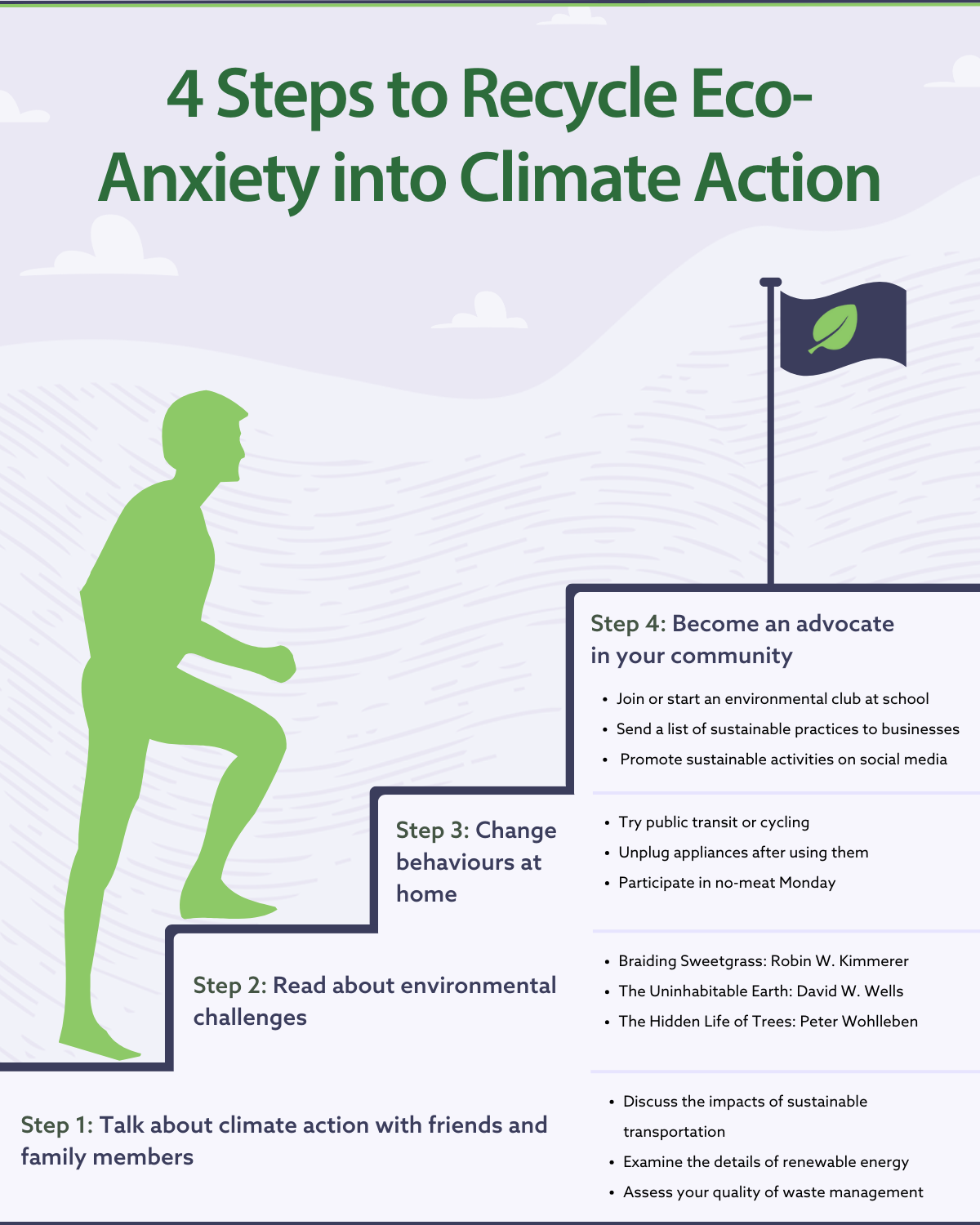From Panic to Action: Eco-Anxiety
Jan 24, 2024
Within the past few years, eco-anxiety has become a prevalent issue. Generally speaking, this phenomenon represents the feelings of distress that accompany growing ecological threats. According to Marks and their colleagues, over 45% of young people in 2021 have reported that eco-anxiety carries negative effects on their everyday lives. Therefore, the aim of this blog is to demonstrate how one can recycle climate anxiety into climate action.
Try to remember the last time you stressed about something like walking through the detector upon leaving Walmart. Haven’t we all felt uneasy in this situation, thinking that it might… ring? Let’s face it, we often stress over things that in reality, aren’t really all that threatening. With some simple adjustments, one might be able to convince themselves that no danger is present in these contexts. The concept of eco-anxiety, however, is different since it is rooted in well-justified concerns and follows from the rational observation that climate change is an actual threat. Aside from its legitimacy, the problem of eco-anxiety can be compared to other anxiety-related issues as it builds through avoidance, an ever-present factor in several mental health problems.

To put the concept of avoidance into perspective, let’s revisit a situation you might have faced in the past. Although the Walmart example might be relatable to many of us, let’s address something even more frightening to illustrate the true nature of avoidance: how about getting stuck in an elevator? In such an event, it would be rather unsurprising to feel panic and high levels of anxiety. After facing this unpleasant experience, the stairs may become your best friend. This occurrence can be explained by a simple rationale: the level of distrust you have acquired for elevators makes you avoid them for as long as possible, hence your decision to hit the stairs.
Although avoidance may provide a short-term solution for your discomfort, it validates your fears by leaving them complacent, increasingly solidifying your distress over time. With this being said, the best way to reverse anxiety is to face its source (i.e., return to the nearest elevator possible). Briefly speaking, avoidant behaviours are what transform negative experiences into long-lasting problems, while exposure to one’s fears is what neutralizes them.

By acknowledging the many similarities that can be drawn from our last example and eco-anxiety, it can be said that identical patterns of avoidance can result from being introduced to the threatening nature of climate change. First comes a speech about environmental destruction, next comes crippling fear. Nevertheless, these exact feelings can often encourage us to push the mere thought of global warming into a dark corner so it never gets touched again. The typical “escape” or avoidant response that derives from eco-anxiety should be perceived as a recognizable threat regarding our battle against the climate crisis, as it prompts disengagement rather than commitment.

To counter these effects, climate activists should aim to help people accept the uncomfortable topic of climate change by implementing behaviours that support the environment. With this in mind, the final sections of this blog will be dedicated to regulating eco-anxiety.
The best way of managing climate anxiety is by getting involved with the issue of concern: an active approach to combating one’s fears is always more effective. In the following list, we have included many ways to do so:
- Read about environmental challenges: Whether you decide to inform yourself about ecological problems through articles, books, and/or courses, becoming familiar with your fears is a favourable way of reducing them.
- Talk about climate action with friends and family members: Needless to say, environmental issues have become a popular topic of conversation. Diminish your levels of anxiety directed toward climate change by discussing real-world solutions.
- Change behaviours at home: Play your part in stopping climate change by taking control of your own behaviours. In most cases, noticeable improvements can be made through changes in electricity usage, dietary practices, and waste management.
- Become an advocate in your community: Voice your opinions and participate in social endeavours, organizing proposals, and creating more opportunities for those who wish to participate in the fight against climate change. Immersing yourself in such projects can help you neutralize personal fears and maximize your impact by enabling others to become a part of environmental initiatives.
The following infographic provides several examples that you can use on a daily basis for confronting eco-anxiety. Remember that when it comes to working on personal fears, starting small and working your way up to bigger accomplishments is ideal!

Since participating in endeavours to fight climate change is the best way to work through eco-anxiety, we hope this blog made you think about climate change as a real anxiety-inducing problem with many solutions. Most importantly, we look forward to seeing you recycle eco-anxiety into climate action!
For more information related to exposure therapy and empowerment-based approaches for combatting eco-anxiety, you may visit Marks and their colleagues’ 2021 article, along with Perakslis’s 2020 publication on Eco-Empowerment.
If you are suffering from eco-anxiety, you may reach out for help at: http://www.chimohelpline.ca/
Author: Sébastien Lebel, Program Coordinator, The Gaia Project
References
- Baudon, P., & Jachens, L. (2021). A scoping review of interventions for the treatment of eco-anxiety. International journal of environmental research and public health, 18(18), 9636.
- Hays, D. (2015, July 17). Hiding face behind hands. Unsplash. https://unsplash.com/photos/selective-focus-photo-of-persons-hand-with-gold-colored-ring-in-it-hdGyEhAMYdo
- López, A. (2019, March 8). Woman standing under pink petaled flowers. Unsplash. https://unsplash.com/photos/woman-standing-under-pink-petaled-flowers-YwnF1Sfsagw
- Marks, E., Hickman, C., Pihkala, P., Clayton, S., Lewandowski, E. R., Mayall, E. E., … & van Susteren, L. (2021). Young people’s voices on climate anxiety, government betrayal and moral injury: A global phenomenon. Government Betrayal and Moral injury: a global phenomenon.
- Patil, R. (2020, October 24). A girl hiding her face with a phone. Unsplash. https://unsplash.com/photos/woman-in-blue-denim-jacket-holding-silver-iphone-6-6VmZrNwV4L4
- Perakslis, C. (2020). Uncertainty Tolerance (UT): Recycling Eco-Anxiety Into Eco-Empowerment [Last Word]. IEEE Technology and Society Magazine, 39(2), 80-80.
- Sikkema, K. (2017, January 28). Traffic Light Sign Underwater. Unsplash. https://unsplash.com/photos/_whs7FPfkwQ
- Stanley, S. K., Hogg, T. L., Leviston, Z., & Walker, I. (2021). From anger to action: Differential impacts of eco-anxiety, eco-depression, and eco-anger on climate action and wellbeing. The Journal of Climate Change and Health, 1, 100003.
- Villasmil, L. (2020, April 9). Young man covered in sticky notes. Unsplash. https://unsplash.com/photos/people-sitting-on-chair-with-brown-wooden-table-mlVbMbxfWI4
Follow us on social for more stories, news and updates:
Facebook: www.facebook.com/gaiaproject
Instagram: @thegaiaproject_
Twitter: @gaiaproject
LinkedIn: @thegaiaproject-projetgaia
TikTok: @thegaiaproject_